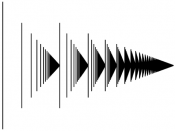Marketing ResearchUniversity of PhoenixâÂÂIntroductionA poorly designed questionnaire may not obtain the results the firm or organization is looking for. There are four categories in which numbers are generally grouped. In increasing order of sophistication, they are (1) nominal numbers, (2) ordinal numbers, (3) intervally scaled numbers, and (4) ratio-scaled numbers. This paper will examine each briefly and how they can be used effectively in the design of a survey questionnaire.
Qualitative DataData that can be categorized into one of several non-numerical categories is qualitative. You are recording some quality that the data possesses. Care needs to be taken to avoid assigning numbers to the categories then computing with them. This type of data is either nominal or ordinal.
NominalThe number we assign to some object, idea, or behavior is entirely arbitrary, although in some cases a tradition may establish the rules of assignment. If measurements are assigned arbitrary numbers, they are called nominal numbers, and their sole purpose in the analysis is to differentiate an item possessing one characteristic from an item possessing a different characteristic.
Nominal data is a type of categorical data in which objects do not have a natural, meaningful order. You can count but not order or measure nominal data. Only calculations based on the frequencies of occurrence are valid. Nominal scales have no numeric properties. Qualitative information is obtained from a nominal scale. This means objects are classified by name only. Counting is the only operation that can be performed on a nominal scale. Examples of nominal questions that may be used are: state of residence; gender; or hair color: blonde, brown, red, black.
OrdinalOrdinal data is a type of categorical data in which objects have a natural and meaningful order but no magnitude. You can count and order, but not measure, ordinal data. Calculations based on an ordering process are valid. Ordinal scales are only crude numeric properties; their numbers cannot be added or subtracted. You can rank-order the objects according to whether they possess more, less of the same amount of the variable being measured. Ordinal scale information obtained is rank order. The differences among objects are valid only relative to the other objects measured (www.statistics.com). Examples of ordinal questions that may be used in questionnaires are: 1st, 2nd, best, worst; opinion: strongly disagree, disagree, agree, strongly agree, no opinion.
Quantitative DataData recorded as meaningful numbers directly representing the measured or observed amount. Examples include number of employees, amount of money in a budget. Do not be confused by numbers used to code or track a characteristic. This is done quite often in database management.
IntervalInterval data is a scale of measurement where the distance between any two adjacent units of measurement is the same. An interval measurement has both order and magnitude but no absolute zero and the zero point is arbitrary. Data values on an interval scale can be added and subtracted but lack meaning for multiplication or division. Interval data are similar to ordinal data in that the assigned numbers order the results. In this case, the differences have an additional meaning. Examples of interval questions that may be used in questionnaires are: dates; measure of longitude; or the heights of tides.
RatioThe ratio level has the characteristics of the interval level, but in addition, the 0 point is meaningful and the ratio between two numbers is meaningful. There are numeric properties to interval scales, and the numbers assigned can not only be meaningfully added or subjected, but also multiplied and divided. The information obtained from a ratio scale is an absolute indication of how much of the underlying construct being measured an object has. In many analyses in marketing, the distinction between interval and ratio scaled data is not very important managerially. Examples of this type of question are: age; education; wages; weight; money; or distance.
ConclusionWhen the population to be studied is large, statisticians use subgroups called samples to conduct their research. The four basic methods for obtaining samples are: random, systematic, stratified, and cluster. Data can be classified as qualitative or quantitative. The four basic types of measurement are nominal, ordinal, interval, and ratio. The applications of statistics are many and varied. People encounter them in everyday life, such as in reading newspapers or magazines, listening to the radio, or watching television.
Referenceswww.statistics.comAaker, D., Kumar, V., & Day, G. (2007). Marketing Research (9th ed.). New York, NY: Wiley.


